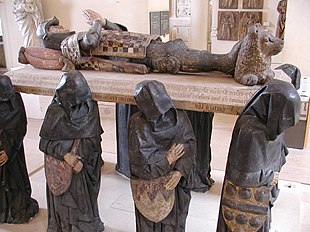
Back فن الشعائر الجنائزية Arabic Funebra arto Esperanto Arte funerario Spanish Art funéraire French Seni pemakaman ID Arte funeraria Italian 장례 예술 Korean ശേഷക്രിയാ കല Malayalam अंत्यविधी कला Marathi Grafkunst Dutch



Funerary art is any work of art forming, or placed in, a repository for the remains of the dead. The term encompasses a wide variety of forms, including cenotaphs ("empty tombs"), tomb-like monuments which do not contain human remains, and communal memorials to the dead, such as war memorials, which may or may not contain remains, and a range of prehistoric megalithic constructs. Funerary art may serve many cultural functions. It can play a role in burial rites, serve as an article for use by the dead in the afterlife, and celebrate the life and accomplishments of the dead, whether as part of kinship-centred practices of ancestor veneration or as a publicly directed dynastic display. It can also function as a reminder of the mortality of humankind, as an expression of cultural values and roles, and help to propitiate the spirits of the dead, maintaining their benevolence and preventing their unwelcome intrusion into the lives of the living.
The deposit of objects with an apparent aesthetic intention is found in almost all cultures – Hindu culture, which has little, is a notable exception. Many of the best-known artistic creations of past cultures – from the Egyptian pyramids and the Tutankhamun treasure, to the Terracotta Army surrounding the tomb of Qin Shi Huang, the Mausoleum of Halicarnassus, the Sutton Hoo ship burial and the Taj Mahal – are tombs or objects found in and around them. In most instances, specialized funeral art was produced for the powerful and wealthy, although the burials of ordinary people might include simple monuments and grave goods, usually from their possessions.
An important factor in the development of traditions of funerary art is the division between what was intended to be visible to visitors or the public after completion of the funeral ceremonies.[1] The treasure of the 18th dynasty Pharaoh Tutankhamun, for example, though exceptionally lavish, was never intended to be seen again after it was deposited, while the exterior of the pyramids was a permanent and highly effective demonstration of the power of their creators. A similar division can be seen in grand East Asian tombs. In other cultures, nearly all the art connected with the burial, except for limited grave goods, was intended for later viewing by the public or at least those admitted by the custodians. In these cultures, traditions such as the sculpted sarcophagus and tomb monument of the Greek and Roman empires, and later the Christian world, have flourished. The mausoleum intended for visiting was the grandest type of tomb in the classical world, and later common in Islamic culture.
- ^ See for example the chapter "Tombs for the Living and the Dead", Insoll 176–87.